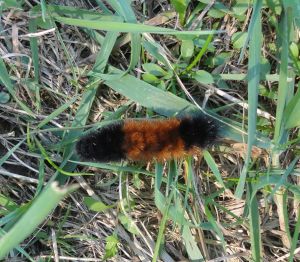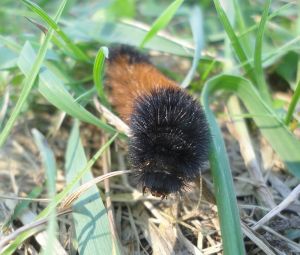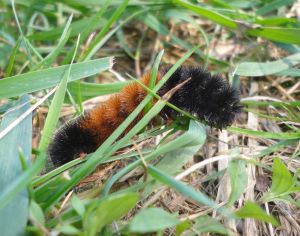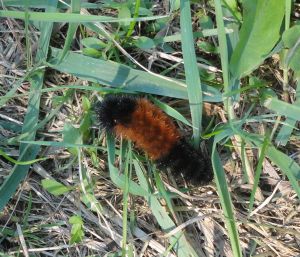The banded woolly bear is the caterpillar stage of the Isabella tiger moth, Pyrrharctia isabella. The furry little caterpillars are common this time of year, as they are actively searching for a good place to spend the winter. The caterpillars curl up in sheltered areas under plant debris. As the temperatures drop below freezing, the baby moths also freeze. Their blood contains an antifreeze that prevents crystals from forming and allows them to survive until spring in an insectile cryogenic state. When warm days arrive they thaw out and go about their business of turning into moths and starting a new generation.
An interesting survival ploy of woolly bears is their response of curling into a ball and playing dead when touched. Not sure how convincing this is for predators, but it must work or their instincts would not have selected for the behavior.
An old wives tale has it that these furry creatures can predict the severity of the winter. Most myths hold that the larger the orange segment, the milder the winter. Some say that a narrow orange stripe means heavy snow and very fuzzy, fat caterpillars mean very cold weather is ahead.
 This caterpillar found making slow progress across our lawn has a fairly large orange segment compared to the black sections. It is also quite large and furry. So does that mean we’ll have a severely cold winter with lots of snow? Or perhaps a very warm winter? Maybe it just means this is an older caterpillar and it grew during a time of relative dryness.
This caterpillar found making slow progress across our lawn has a fairly large orange segment compared to the black sections. It is also quite large and furry. So does that mean we’ll have a severely cold winter with lots of snow? Or perhaps a very warm winter? Maybe it just means this is an older caterpillar and it grew during a time of relative dryness.
According to entomologists, banded woolly bears shed their skin, or molt, six times before they are mature enough to pupate. Each time they shed, it is because the original skin is too small and their body is larger. The biggest caterpillars are oldest. They also tend to get more black on them as they age and black seems to develop more when the weather is damp. So if you find a big woolly bear that is mostly black, that doesn’t mean a new ice age is arriving. It is much more likely the caterpillar is nearing maturity and it has experienced a rainy summer.



You must be logged in to post a comment.